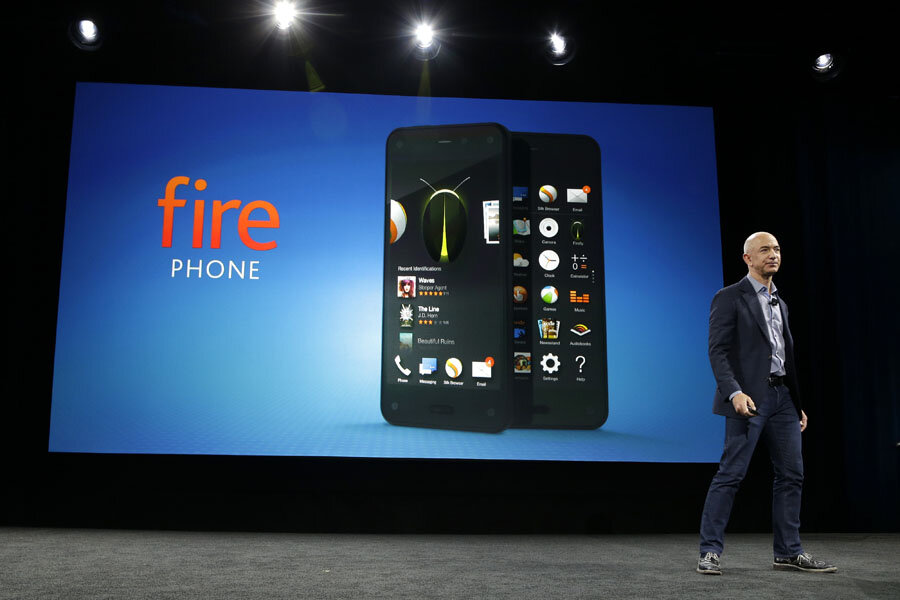Amazon debuts Fire Phone: 3-D images, gesture controls, and scanning tech
Loading...
Amazon pulled out all the stops for the unveiling of its first smart phone on Wednesday, with flashy innovations and a connected eco-system that presents a major challenge to Samsung, Apple, Google, and other reigning kings of smart mobile tech.
From an interactive 3-D imaging feature that lets users control the screen with a nod of their head or the flick of their hand, to a button that automatically recognizes and retrieves information about hundreds of millions of items, Amazon’s new Fire Phone proved to be a release that just might shake up the hyper-competitive smart phone game.
Amazon chief executive Jeff Bezos opened the Fire Phone event, held at Amazon’s Seattle headquarters Wednesday morning, by touting Prime, Amazon Instant Video, and Kindle, which all received early skepticism but went onto be successful among Amazon customers. With that in mind, he said Amazon wanted to create a device with customer needs in mind.
"It's time to whip the crown from Apple,” he says at the event. "Can we build a better phone for our most engaged customers? Can we build a better phone for Amazon Prime members?"
Mr. Bezos believes Amazon has. And that phone is chock full of features that will have shoppers locked in the Amazon commerce and entertainment ecosystem.
Case in point, a new feature called Firefly. Firefly is recognition technology that has catalogued knowledge of more than 100 million images, products, and contact details. Firefly is turned on by pressing a small button on the side of the phone, and will scan whatever item is in its vicinity. Users scan whatever item they want to know more about – anything from a painting hanging in a friend’s apartment to a jar of Nutella – and Firefly will search its stores for more information on the item, plus likely link to that item or something related on the Amazon store. It even can scan music, movies, and TV shows (down to the episode and scene), plus phone numbers, e-mail addresses, and QR codes.
Once Amazon has customers connected to its store through Firefly, those using the Fire Phone will be presented with one of the most high-tech mobile shopping experiences available: Dynamic Perspective.
Dynamic Perspective is the long-rumored Amazon feature that combines 3-D imaging with gesture recognition to integrate browsing the Internet (read: Amazon’s online store) with natural movements. Dynamic Perspective features a variety of one-handed commands, including tilting the phone side to side in order to see the lyrics of whatever song is playing or flipping to the next item on an online store, and tilting the phone down to set the screen on auto-scroll while reading an article or book.
Then, as users change the angle at which they are looking at the screen, the object follows the movement of their head, opening up new angles on each screen image. For example, if a user wanted to see another side of the Empire State building on the maps function, they would simply move their head to the side of the screen, and the screen image would adjust to show the side of the building. The Fire Phone has four different cameras watching and recognizing head movement at all times, plus infrared vision for night browsing.
There are also hand gestures that allow users to quickly send messages. For example, if someone is running late to a meeting, they can send a note alerting others attending the meeting with the flick of the wrist.
Aside from these two features, the Fire Phone packs in a wealth of little features that continue to connect the smart phone user to Amazon functions. It comes with free Mayday customer support (just like the Kindle Fire tablet) and has full access to the Kindle library, plus Fire TV streaming video apps (such as Hulu, Netflix, and others). It offers a 13.1-megapixel rear camera with free unlimited photo storage through the Amazon Cloud. It has a 4.7 inch LCD screen with Gorilla Glass, a 2.2 GHZ processor, 2 GB of RAM, and will run on Amazon’s version of Android, Fire OS. It has Advanced Streaming and Prediction (ASAP) that can predict the shows customers will want to stream based on previous viewing and preferences. It also has Second Screen, which lets customers switch between Amazon devices, such as Kindle or Fire TV, and access the same content.
“Fire Phone puts everything you love about Amazon in the palm of your hand -- instant access to Amazon’s vast content ecosystem and exclusive features," Bezos says in a statement.
The Fire Phone will be sold exclusively on AT&T for $199 on a two-year contract, or $649 unlocked, starting July 25. That price also includes a free year of Amazon Prime.
"The question is, a few years from now, will this Fire Phone be remembered as one of the wireless [industry's] key moments, like when the first Apple iPhone or Google Android or Samsung Galaxy was introduced?" says industry analyst Jeff Kagan to the Los Angeles Times. "Or will this not be as big a smartphone competitor, but another way for Amazon.com customers to shop?"






